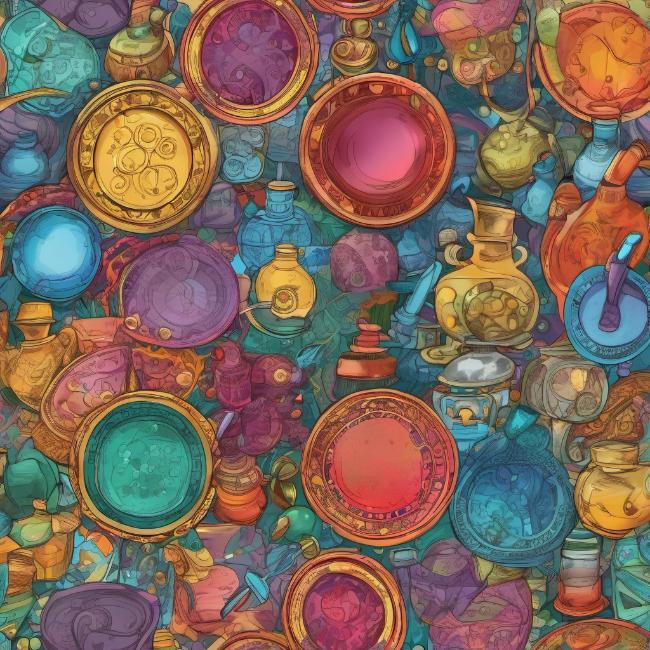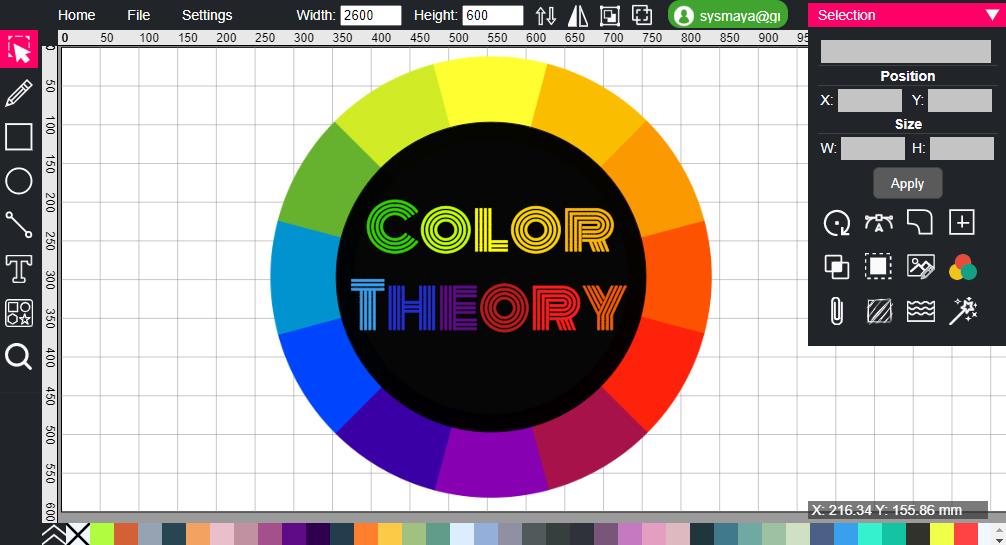The Chromatic Palette of Humanity - A Journey Through Time
Since the dawn of humanity, humans have been captivated by the rich tapestry of colors that surrounds them. Pigments and dyes have played a crucial role in the evolution of society, not only as aesthetic elements but also as silent witnesses to the history of humanity. In this analysis, we will explore the history of mankind through the unique lens of colors, from primitive plant and mineral pigments to the sophisticated blends of color artisans and master artists.
The First Strokes of Color

The story of man and colors intertwines at the dawn of civilization. Initially, humans used natural pigments obtained from minerals and plants to breathe life into their artistic expressions and ceremonial rituals. Earthy ochres and reddish tones extracted from the earth, as well as greens and blues derived from plants, adorned the early human creations on cave walls and rocky surfaces.
In this primal canvas, our ancestors ventured into the world of color with a profound connection to the earth. The ochre tones, often obtained from iron oxides, served not only as a means of creative expression but also as symbolic representations of life, energy, and the primal forces of nature. Red hues, extracted from plants or clays rich in iron, carried a spiritual significance, symbolizing vitality and the essence of existence.
The greens and blues, sourced from the plant kingdom, reflected the intimate relationship between early humans and their natural surroundings. These colors, associated with vegetation and water, played a pivotal role in expressing the connection between mankind and the life-sustaining elements of the environment. Cave paintings adorned with these hues told stories of survival, the hunt, and the essential dance between humans and nature.
These primitive pigments were not mere adornments; they were the language through which ancient communities communicated with the cosmos. Ceremonial rituals, often centered around the application of these colors on the body or on sacred objects, were a way to bridge the earthly and the divine. The ochre-stained hands of our ancestors left an indelible mark on the walls of history, serving as both a testament to their artistic inclinations and a bridge to the spiritual realms.
As we delve into the first strokes of color, we encounter not just pigments on surfaces but a profound narrative of humanity's attempt to understand and capture the essence of existence. These early hues, extracted from the very fabric of the earth and vegetation, laid the foundation for a chromatic journey that would unfold through the annals of time.
The Alchemy of Pigments

Over time, color artisans began to explore the alchemy of pigments, unraveling the secrets of nature to create more vibrant and enduring shades. Discoveries like Egyptian blue and Tyrian purple became coveted treasures, marking a connection between human skill and the chromatic richness of nature.
In later eras, artists assumed the role of alchemists, transcending the mere application of colors to become creators of their exclusive palettes. The technique of mixing and matching pigments evolved into an art form, a subtle alchemy where artists harnessed their skill and intuition to craft hues that spoke to the depths of human emotion. The secrets of this chromatic alchemy were closely guarded, passed down with reverence from master to apprentice, forming a lineage of color artisans.
As the Renaissance unfolded, artists delved into the intricacies of color theory, seeking not only to replicate the world as they saw it but to elevate their creations to new levels of aesthetic brilliance. Pigments were no longer mere tools; they were the ingredients of a magical concoction, carefully blended to evoke specific emotions, tell intricate stories, and capture the essence of beauty.
Artists' workshops became crucibles of creativity, where experimentation with pigments and their combinations led to the birth of entirely new colors. The search for the perfect shade became an obsession, driving artists to explore the natural world, chemistry, and even mysticism in their quest for chromatic perfection. The emergence of groundbreaking pigments, such as the vibrant Cadmium Reds and mysterious Cobalt Blues, marked the triumphs of these artistic alchemists.
The transmission of knowledge within these ateliers became a sacred tradition. The mentorship of a master artist was akin to an initiation into a secretive brotherhood of color craftsmen. Techniques for creating specific shades were passed down orally, guarded like precious gems in the treasure chest of artistic wisdom. Each apprentice brought their unique perspective, adding new dimensions to the evolving palette of human creativity.
Royal courts became patrons of these color alchemists, vying for the services of the most talented and experienced painters. The richness and diversity of a court's artistic endeavors became a testament to its cultural refinement and power. Artists found themselves not only creators of visual masterpieces but also advisors to rulers, guiding them on the strategic use of color symbolism in politics, heraldry, and portraiture.
In this chapter of the chromatic saga, artists emerged not just as painters but as alchemists, wielding brushes like wands to weave enchanting tapestries of color. Their creations transcended the canvas, leaving an indelible mark on the cultural fabric of societies and inspiring generations to come.
Artists as Alchemists

In later eras, artists took on the role of alchemists, creating their exclusive colors. The technique of mixing and matching pigments became an art form in itself, and the secrets of the palette were passed down from master to apprentice. Artists' workshops flourished, and royal courts vied to have the most talented and experienced painters.
In ancient epochs, artists assumed the mantle of alchemists, weaving enchantment with pigments and brushes beneath the soft glow of candlelight. The alchemy of color was a mystical dance between the tangible and the ethereal, where painters sought to transmute base materials into hues that resonated with the very essence of human emotion and experience.
Within dimly lit studios, artists meticulously ground pigments sourced from the earth, minerals, and plants. The flickering flame of a candle cast shadows upon the alchemist-painter, whose hands moved with precision and intent. The workshop, imbued with an atmosphere of secrecy and reverence, became a crucible where raw pigments transformed into an elixir of vibrant colors.
Much like alchemists in pursuit of the philosopher's stone, artists sought the perfect amalgamation of pigments to create transcendent hues. The search for the elusive and the extraordinary led to experiments with exotic materials, often with a touch of the arcane. The alchemy of color extended beyond the technical; it became a spiritual endeavor, a quest for enlightenment through the language of hues.
The palette, akin to an alchemical grimoire, held the guarded secrets of color harmonies and transformative combinations. Masters passed down their esoteric knowledge to apprentices, and each stroke of the brush became a ritualistic incantation, conjuring emotions and narratives onto canvases.
The alchemy of color was a slow, deliberate process, resonating with the rhythms of the cosmos. Patience was a virtue, and time was an essential ingredient. As pigments were carefully layered, mixed, and applied, artists engaged in a form of meditation, channeling the energy of their surroundings into their creations.
The alchemy of color extended beyond the canvas, influencing the spiritual and cultural landscapes of societies. Certain pigments were endowed with symbolism, carrying the weight of traditions, rituals, and societal structures. Artists, much like alchemists, became interpreters of the mystical language of colors, translating the ineffable into visual poetry.
In this chapter, we delve into the alchemy of color, where artists, surrounded by the flicker of candlelight, sought to unlock the secrets of the universe through pigments and brushes. The legacy of this magical era lives on in the masterpieces that emerged from these alchemical studios, reminding us that the creation of art, like alchemy, is a transformative and timeless endeavor.
The Industrial Revolution and the Democratization of Color
With the advent of the Industrial Revolution, pigment manufacturing became industrialized, democratizing access to colors. Tube paints and synthetic pigments opened up new possibilities for creativity, allowing artists and craftsmen to explore a broader range of tones and hues.
With the advent of the Industrial Revolution, the realm of colors underwent a transformative shift. The manufacturing processes that revolutionized various industries also left an indelible mark on the world of pigments and hues. The once artisanal craft of creating exclusive colors became an industrial endeavor, marking a new chapter in the history of mankind and color.
As factories sprang up, they replaced the meticulous handcrafting of pigments with large-scale production methods. Pigments that were once rare and carefully guarded became accessible to a broader audience. The democratization of color unfolded, allowing a more extensive spectrum of society to engage with and appreciate the vibrant world of hues.
Tube paints, a revolutionary invention of the 19th century, provided artists with a convenient and portable means to carry an array of colors. This innovation liberated artists from the constraints of fixed palettes, empowering them to explore their creativity with newfound freedom. The once-arduous process of grinding pigments and preparing paints was streamlined, allowing artists to focus more on their artistic vision.
Synthetic pigments, born out of chemical advancements, expanded the color palette beyond the limitations of naturally occurring substances. Artists now had access to an array of colors that were brighter, more stable, and often more affordable. The introduction of synthetic dyes into the textile industry further transformed the visual landscape, influencing fashion and design in unprecedented ways.
The impact of this industrial revolution was not confined to the artistic realm alone. Colored prints, posters, and eventually photographs became increasingly prevalent, ushering in a new era of visual communication. The vibrant colors of advertisements and mass-produced images permeated everyday life, shaping the collective visual experience of societies.
This chapter marks a significant turning point where the exclusivity of color was replaced by accessibility, and the once-guarded secrets of pigments became common knowledge. The democratization of color reflects not only technological progress but also a societal shift where the visual arts became a more integral part of the collective human experience.
Color in the Digital Age
Today, the story of man and colors has taken a turn towards the digital era. The screen has become a canvas, and the palette has exponentially expanded with the introduction of pixels and color codes. Humanity's relationship with colors has evolved into a more immediate and global interaction, transforming how we perceive and create.
In this digital realm, artists wield styluses and keyboards as their modern brushes and pigments. The traditional constraints of physical mediums dissolve as the virtual canvas offers limitless possibilities. The language of pixels allows for an infinite spectrum of colors, each one meticulously placed to create vivid and dynamic compositions. Artists no longer grind pigments by hand but manipulate the RGB values, engaging in a different form of digital alchemy.
The democratization of creativity has reached new heights as digital tools and platforms enable individuals from diverse backgrounds to explore their artistic inclinations. Social media serves as a vast gallery where creations can be instantly shared and appreciated, fostering a global conversation about color and culture. The immediacy of this interaction accelerates the evolution of trends and styles, making the digital age a melting pot of influences.
The very nature of color perception has shifted in the digital era. Screens emit light rather than reflecting it, altering the way we experience colors. Artists now consider not only the composition on the screen but also how it will be perceived across various devices. The concept of color has become more fluid, adapting to the dynamic nature of the digital landscape.
Technology has not only changed the way we create but also how we consume color. Augmented reality (AR) and virtual reality (VR) further immerse individuals in vibrant, interactive experiences, pushing the boundaries of what was once confined to two-dimensional surfaces. The intersection of technology and color has given birth to new forms of art that transcend the traditional boundaries of canvas and paint.
As we navigate the digital age, the story of man and colors continues to evolve, marked by the pulsating hues of screens and the ever-expanding palette of possibilities. The alchemy of color takes on a new form, where algorithms and digital tools become the conduits through which artists express the complexities of the human experience. The journey that began with ancient pigments now unfolds in the digital realm, ensuring that the timeless dialogue between mankind and colors remains an ever-changing and fascinating narrative.
The history of man and colors is a fascinating narrative of discoveries, innovations, and artistic expressions. From the humble origins of natural pigments to the digital age, colors have been witnesses and active participants in the evolution of humanity. Through the chromatic palette, we can unravel the threads of our history, discovering the complexities and beauties that have marked our journey through time.






